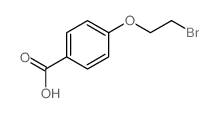18800-34-5
| Name | 1-(2-bromoethoxy)-4-methylbenzene |
|---|---|
| Synonyms |
1-(2-Bromoethoxy)-4-methylbenzene
F3284-8129 MFCD00082852 2-bromoethyl 4-methylphenyl ether |
| Density | 1.349g/cm3 |
|---|---|
| Boiling Point | 107-108ºC (8 mmHg) |
| Melting Point | 37-38ºC |
| Molecular Formula | C9H11BrO |
| Molecular Weight | 215.08700 |
| Flash Point | 104.1ºC |
| Exact Mass | 213.99900 |
| PSA | 9.23000 |
| LogP | 2.76870 |
| Vapour Pressure | 0.0173mmHg at 25°C |
| Index of Refraction | 1.541 |
Synonym: Section 2 - COMPOSITION, INFORMATION ON INGREDIENTS
Risk Phrases: 20/22 36/37/38 Section 3 - HAZARDS IDENTIFICATION EMERGENCY OVERVIEW
Harmful by inhalation and if swallowed. Irritating to eyes, respiratory system and skin. Potential Health Effects Eye: Causes eye irritation. Skin: Causes skin irritation. May be harmful if absorbed through the skin. Ingestion: Harmful if swallowed. May cause irritation of the digestive tract. Inhalation: Harmful if inhaled. Causes respiratory tract irritation. Chronic: Not available. Section 4 - FIRST AID MEASURES Eyes: Flush eyes with plenty of water for at least 15 minutes, occasionally lifting the upper and lower eyelids. Get medical aid. Skin: Get medical aid. Flush skin with plenty of water for at least 15 minutes while removing contaminated clothing and shoes. Ingestion: Get medical aid. Wash mouth out with water. Inhalation: Remove from exposure and move to fresh air immediately. If not breathing, give artificial respiration. If breathing is difficult, give oxygen. Get medical aid. Notes to Physician: Treat symptomatically and supportively. Section 5 - FIRE FIGHTING MEASURES General Information: As in any fire, wear a self-contained breathing apparatus in pressure-demand, MSHA/NIOSH (approved or equivalent), and full protective gear. Extinguishing Media: Use water spray, dry chemical, carbon dioxide, or chemical foam. Section 6 - ACCIDENTAL RELEASE MEASURES General Information: Use proper personal protective equipment as indicated in Section 8. Spills/Leaks: Vacuum or sweep up material and place into a suitable disposal container. Section 7 - HANDLING and STORAGE Handling: Avoid breathing dust, vapor, mist, or gas. Avoid contact with skin and eyes. Storage: Store in a cool, dry place. Store in a tightly closed container. Section 8 - EXPOSURE CONTROLS, PERSONAL PROTECTION Engineering Controls: Facilities storing or utilizing this material should be equipped with an eyewash facility and a safety shower. Use adequate ventilation to keep airborne concentrations low. Exposure Limits CAS# 18800-34-5: Personal Protective Equipment Eyes: Not available. Skin: Wear appropriate protective gloves to prevent skin exposure. Clothing: Wear appropriate protective clothing to prevent skin exposure. Respirators: Follow the OSHA respirator regulations found in 29 CFR 1910.134 or European Standard EN 149. Use a NIOSH/MSHA or European Standard EN 149 approved respirator if exposure limits are exceeded or if irritation or other symptoms are experienced. Section 9 - PHYSICAL AND CHEMICAL PROPERTIES Physical State: Crystals Color: white Odor: Not available. pH: Not available. Vapor Pressure: Not available. Viscosity: Not available. Boiling Point: 107 - 108 deg C @8mmHg Freezing/Melting Point: 37 - 38 deg C Autoignition Temperature: Not available. Flash Point: 110 deg C ( 230.00 deg F) Explosion Limits, lower: Not available. Explosion Limits, upper: Not available. Decomposition Temperature: >150 deg C Solubility in water: Specific Gravity/Density: Molecular Formula: C9H11BrO Molecular Weight: 215.09 Section 10 - STABILITY AND REACTIVITY Chemical Stability: Not available. Conditions to Avoid: Incompatible materials. Incompatibilities with Other Materials: Strong oxidizing agents. Hazardous Decomposition Products: Carbon monoxide, carbon dioxide, hydrogen bromide. Hazardous Polymerization: Has not been reported. Section 11 - TOXICOLOGICAL INFORMATION RTECS#: CAS# 18800-34-5 unlisted. LD50/LC50: Not available. Carcinogenicity: 1-(2-Bromoethoxy)-4-methylbenzene - Not listed by ACGIH, IARC, or NTP. Section 12 - ECOLOGICAL INFORMATION Section 13 - DISPOSAL CONSIDERATIONS Dispose of in a manner consistent with federal, state, and local regulations. Section 14 - TRANSPORT INFORMATION IATA Shipping Name: Not regulated. Hazard Class: UN Number: Packing Group: IMO Shipping Name: Not regulated. Hazard Class: UN Number: Packing Group: RID/ADR Shipping Name: Not regulated. Hazard Class: UN Number: Packing group: Section 15 - REGULATORY INFORMATION European/International Regulations European Labeling in Accordance with EC Directives Hazard Symbols: XN Risk Phrases: R 20/22 Harmful by inhalation and if swallowed. R 36/37/38 Irritating to eyes, respiratory system and skin. Safety Phrases: S 26 In case of contact with eyes, rinse immediately with plenty of water and seek medical advice. S 37/39 Wear suitable gloves and eye/face protection. WGK (Water Danger/Protection) CAS# 18800-34-5: No information available. Canada None of the chemicals in this product are listed on the DSL/NDSL list. CAS# 18800-34-5 is not listed on Canada's Ingredient Disclosure List. US FEDERAL TSCA CAS# 18800-34-5 is not listed on the TSCA inventory. It is for research and development use only. SECTION 16 - ADDITIONAL INFORMATION N/A |
| Hazard Codes | Xn: Harmful; |
|---|---|
| Risk Phrases | R36/37/38 |
| Safety Phrases | S37/39 |
|
~71% 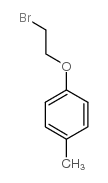
18800-34-5 |
| Literature: Slyn'ko; Tormyshev Russian Journal of Organic Chemistry, 2000 , vol. 36, # 2 p. 254 - 257 |
|
~% 
18800-34-5 |
| Literature: US2003/212094 A1, ; |
|
~62% 
18800-34-5 |
| Literature: Marona, Henryk; Antkiewicz-Michaluk, Lucyna Acta Poloniae Pharmaceutica - Drug Research, 1998 , vol. 55, # 6 p. 487 - 498 |
|
~% 
18800-34-5 |
| Literature: Bulletin de la Societe de Chimie Biologique, , vol. 27, p. 562,563 |
| Precursor 4 | |
|---|---|
| DownStream 9 | |


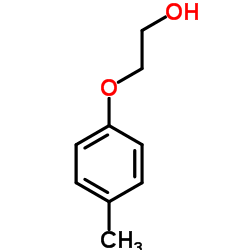
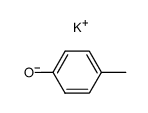
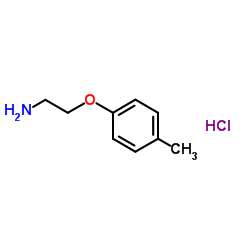
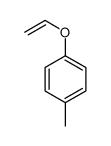
![2-[2-(4-methylphenoxy)ethylsulfanyl]-1,3-benzothiazole structure](https://image.chemsrc.com/caspic/309/334501-89-2.png)
![Benzene,1,1'-[1,2-ethanediylbis(oxy)]bis[4-methyl- structure](https://image.chemsrc.com/caspic/118/15149-11-8.png)




